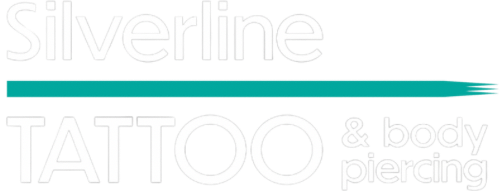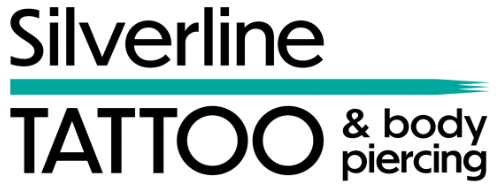Tattoo Aftercare Instructions
First Day Aftercare
Tattoos are tender for the first couple of days, sometimes upwards of a week. Some tattoos can have slight bruising, and a lot of times, some swelling is apparent. Drink a lot of fluids and try to keep any movement or contact with your fresh tattoo minimal. Your artist took the care to cover up your new tattoo to keep air-borne bacteria from invading your wound. Open flesh is a breeding ground for bacteria and infection. Leave the bandage on for a minimum of two to three hours, or as otherwise directed by your artist.
Taking off the bandage
WASH YOUR HANDS Make sure you wash them every time you touch your tattoo. NO EXCEPTIONS!!
After removing the bandage, wash your tattoo. Use lukewarm water and mild unscented soap (Dove, SpectroGel, Ivory) to gently wash away any ointment, blood, and/or plasma and to completely clean the area. DO NOT use a washcloth or anything abrasive, use your hands. Allow your tattoo to air dry or pat dry with a PAPER towel. Let your tattoo dry out overnight before applying aftercare, as recommended by your artist. Do not cover your tattoo after you have taken the bandage off. You need to let it breathe.
Tegaderm Aftercare
Tegaderm is a breathable, flexible bandage for your tattoo that’s intended to lock in your body’s natural healing fluids while protecting it from all outside contact. Because it’s permeable to gasses, it allows your skin to “breathe” and therefore is safe to leave on for up to four days following the tattoo procedure. Once removed, your tattoo has gone through most of the healing process already, and should only have minimal peeling and flaking from there on out. When you leave the shop with your bandage on, your job is essentially done for the next four days. Just keep an eye on it to make sure that the seal around the edges has not broken, allowing outside contact with your tattoo. It is completely normal for fluid to build up inside of the bandage, this is a mixture of your body’s normal weeping/healing process, and while it may look a little gross, it’s all as it should be! The only time you should remove your bandage is if that seal is broken and exposes the tattoo. Tegaderm is technically a waterproof bandage, however, we do not recommend prolonged exposure to water during this time, because it can weaken the adhesive. After four days, gently remove your bandage. Do this by starting at one corner and slowly pulling down, in the direction of hair growth. We recommend removing it in the shower; the hot water will loosen the adhesive and will help it to peel off easily. Once it’s removed immediately wash your tattoo using an unscented soap. Rinse thoroughly with warm water and let it air dry.
Moisturizing and Aftercare
Tattoos generally take anywhere from 3-6 weeks on average to heal. Everyone is
different, and times can vary based on other factors, like the location of the tattoo, and your overall health will affect how you heal. Your new tattoo may or may not scab in some places, this varies from person to person, area to area, and often depends on how much you bled during your tattoo. You will want to apply a thin layer of unscented moisturizer, such as Aveeno, Lubriderm, or Curel, or a specialty product, like AfterInked or H2Ocean which are tailored to assist in tattoo healing. Remember, you want your skin to be moisturized, not WET. You can wipe off any excess with a clean paper towel, and leave it. Do not apply too much moisture to your new tattoo, as any new scabbing that may be occurring will become porous and could cause infection. Applying moisturizer anywhere from 1 to 3 times daily will ensure you are not over-moisturizing.
General Aftercare
In the first 1-4 weeks, your tattoo will go through a couple of different processes as the skin heals itself. The first is sore and red, sensitive to the touch, potentially swollen, and maybe some bruising. This is all completely normal. The skin reacts to a tattoo with healing the same as it would if you scraped yourself. After the redness and swelling goes down, you may begin to notice some scabbing. DO NOT pick the scabs, as they are attached to your tattoo, and you can cause the ink to fall out in some places by doing this. If it is obvious you have picked your tattoo, you will also lose your opportunity to have a free touch-up by your artist, as it is only guaranteed if you have properly followed aftercare instructions.
After about the first week, you may find the skin feels a little tight around the area, and it may be itchy and in some places, peeling or flaking. The new skin that has formed is very fragile and thin, so DO NOT scratch your tattoo.
If you feel like it’s very itchy, you can slap the area gently to relieve some of the itchiness. After all the peeling and itching have subsided, you may think your tattoo is fully healed. However, you will notice that the skin will have a sheen to it, or will look sort of shiny. This is the last part of the healing process. You need to continue to moisturize as you have been until the skin is no longer shiny. A good indicator is feeling an area of your skin near the tattoo, and then feeling the tattoo itself. If the texture of the skin is different, then your tattoo is not healed.
In this time of healing, you must refrain from:
- Going into any public bodies of water (pools, hot tubs, baths, etc.)
- Keep your tattoo out of the sun (sunscreen with a minimum SPF of 30 or more after the tattoo is healed)
- Do not molest or over-touch your tattoo
- Do not wear tight clothing over your new tattoo
- DO NOT USE VASELINE or Polysporin or sunscreen
All the healing must be complete before any work can be done again on the tattoo. Color loss and fading are usually more apparent in tattoos that are solid black or solid colors and are common. We DO guarantee our tattoos, as long as the PROPER aftercare was carried out. You can contact us for a touch-up free of charge! Your artist more than likely will want to see the tattoo, to ensure you listened to their aftercare instructions. You may want to schedule your touch-up within about 1-6 months from the original date you were tattooed, to ensure that the colors will match, and any fading from exposure to the sun will be uniform. Touch-ups scheduled after 6 months will result in a set-up fee payable to the artist.
Troubleshooting Advice
You may have an infection if:
- You are experiencing prolonged tenderness, swelling of line work, and
redness in the area 4-6 days after the tattoo was done. - Green/Yellow/Coloured discharge or puss coming out of the tattoo (If you
have a green or yellow tattoo, it will NOT be the same color) - Greenish or discolored scabs
What should you do?
If you are experiencing any of these symptoms, please come in as soon as possible so we can have a look at it. If you are unable to come in, we recommend discontinuation whatever cream you are using, applying a thin layer of Polysporin cream to the area, leaving it overnight, and trying to get in to see an artist as soon as possible. Consult a physician if you are concerned. Sometimes, a simple irritation of the skin can be misinterpreted as an infection, and we want to ensure that you are healing properly. Tattoos on the wrists, ankles, and feet tend to take a bit longer to heal because they are such high-traffic areas.

